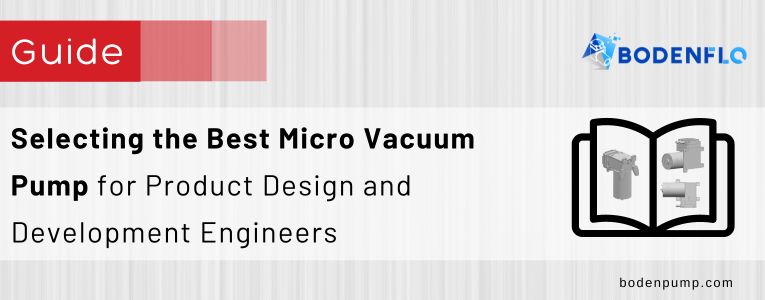
In my role as the project manager at BODENFLO, specializing in miniature vacuum pumps, I’ve had firsthand experience with the challenges and nuances of selecting the perfect components for complex engineering projects. Choosing the right micro vacuum pump isn’t just a technical decision; it’s about marrying functionality with innovation to enhance product performance and reliability.
The key to selecting the best micro vacuum pump lies in understanding the specific needs of your application and matching them with the right features and specifications of the pump. It’s about ensuring that every component aligns perfectly with your design goals, optimizing both cost and functionality for superior product performance.
Navigating the myriad options available can be daunting, but with the right approach, you can pinpoint the ideal solution that meets your project requirements. This guide is designed to walk you through the essential steps in selecting a micro vacuum pump that will elevate your product design.
What Is a Micro Vacuum Pump?
A dc micro vacuum pump works by using a small piston or diaphragm that moves back and forth to pull air out of a chamber, effectively creating a vacuum by reducing the air pressure inside. This mechanism is essential for applications where precise air evacuation is crucial, such as in medical devices, laboratory equipment, and consumer electronics. The compact design of these pumps allows them to fit into small spaces, making them ideal for high-tech environments where efficiency and reliability are paramount.
More about micro vacuum pumps.
Why Is the Right Vacuum Pump Critical for Product Success?
Selecting the appropriate vacuum pump is crucial for the operational success and longevity of a product. An unsuitable pump can have significant negative impacts:
Key Impacts of Incorrect Vacuum Pump Selection:
- Inadequate Performance: A mismatched pump may not meet the required pressure or volume specifications, leading to inefficient system operation and failure to achieve desired results.
- Increased Operational Costs: Inefficiencies can lead to higher energy consumption and operational costs, diminishing the overall profitability and sustainability of the product.
- Accelerated Wear and Tear: Using an unsuitable pump increases the strain on system components, potentially leading to more frequent breakdowns and higher maintenance costs.
- Reduced Product Longevity: Premature failures can decrease the lifespan of the product, impacting the long-term reliability that customers expect.
- Customer Dissatisfaction: Failure to deliver expected performance can lead to customer dissatisfaction and damage to the brand's reputation, affecting market success.
Benefits of Choosing the Correct Vacuum Pump:
- Longevity: The correct pump is less likely to cause downstream problems, extending the overall lifespan of the product.
- Optimal Performance: Properly matched pumps perform efficiently within the system’s specifications, delivering the required outcomes without overexertion.
- Enhanced Efficiency: The right vacuum pump operates more efficiently, reducing energy usage and operational costs, contributing to the sustainability of the product.
- Increased Reliability: A suitable pump minimizes the risk of operational issues, ensuring consistent performance and fewer interruptions.
How Do I Determine the Specifications Needed?
Assess Your Requirements
Begin by defining the operational requirements of your project. Consider factors such as the required vacuum level, flow rate, and power consumption. These parameters will guide you in narrowing down your choices to those pumps that can meet or exceed the technical demands of your application.
Evaluate the Environment
The environment in which the pump will operate is just as crucial. Factors such as ambient temperature, humidity, and exposure to chemicals or contaminants can significantly affect the pump's performance and durability. Choose a pump that can withstand these environmental conditions to avoid premature failure.
What Types of Vacuum Pumps Are Available?
Vacuum pumps can vary significantly in size and power source, each type tailored to specific applications and operational requirements. Here’s a breakdown of micro vacuum pumps (typically DC) and larger vacuum pumps (often AC), highlighting their unique advantages:
Micro Vacuum Pumps (DC)
Diaphragm Pumps:
- Applications: Perfect for environments that require a clean, oil-free vacuum such as medical devices or laboratory equipment.
- Features: These pumps offer robustness, low maintenance, and resistance to chemicals, making them ideal for precise and clean operations.
- Power Source: Typically powered by DC, making them suitable for portable or battery-operated devices where compact and efficient vacuum creation is necessary.
- Explore diaphragm pumps.
Piston Pumps:
- Applications: Commonly used in automotive and consumer electronics where a durable and reliable vacuum source is necessary.
- Features: These pumps operate by moving a piston back and forth within a cylinder, providing a reliable vacuum with a straightforward mechanical design.
- Power Source: Often powered by DC for use in applications where space and energy efficiency are critical.
- Learn more about piston pumps.
Larger Vacuum Pumps (AC)
Rotary Vane Pumps:
- Applications: Suitable for industrial applications requiring a high vacuum, such as in manufacturing processes and heavy-duty material handling.
- Features: These pumps are known for their durability and high efficiency but require more maintenance due to mechanical wear on the vanes.
- Power Source: Typically powered by AC, which supports their use in stationary applications where higher power and continuous operation are needed.
- Discover rotary vane pumps.
Table: Key Considerations for Choosing a Micro Vacuum Pump
Choosing the right micro vacuum pump involves evaluating several critical factors to ensure optimal performance and reliability in your specific application:
| Category | Consideration | Details |
|---|---|---|
| Technical Specifications | Performance Requirements | Define required vacuum levels and flow rates. Check pump speed, pressure capabilities, and compatibility with gases. |
| Size and Footprint | Assess pump dimensions and weight. Choose compact designs for limited spaces, ensuring easy integration. | |
| Operational Considerations | Longevity and Maintenance | Evaluate lifespan and maintenance needs. Opt for durable models with minimal maintenance to lower operational costs. Consider seal integrity, lubrication needs, and service intervals. |
| Mode of Operation | Select pumps based on usage: robust models for continuous operation and flexible models for intermittent use. | |
| Environmental and Safety | Environmental Considerations | Consider temperature, humidity, and exposure to chemicals. Select pumps that perform reliably under these conditions. |
| Noise Levels | Evaluate noise emissions. Prefer pumps with noise reduction features to minimize disturbance. | |
| Economic Factors | Cost Considerations | Balance cost with reliability. Higher-cost pumps usually offer better durability and continuous operation. |
| Power and Efficiency | Power Requirements | Understand the power supply (AC or DC) and energy consumption. Choose pumps that match your power setup and efficiency goals. |
| Customization and Features | Application-Specific Features | Look for features like integrated controllers, variable speed drives, or special coatings for enhanced performance in targeted applications. |
| Supplier and Support | Supplier Support and Reputation | Choose reputable suppliers with reliable support, available spare parts, and solid warranties. |
How Can I Ensure the Pump Integrates Seamlessly with My Design?
Compatibility
Ensure that the pump’s dimensions, power requirements, and control interfaces are compatible with your product design. It should integrate seamlessly without requiring major modifications to other components. Integration tips for vacuum pumps.
Testing
Before finalizing your choice, conduct thorough testing to verify that the pump performs well under your specific conditions. This step is critical to ensure reliability before mass production.
Conclusion
Selecting the right miniature vacuum pump is essential for the success of your product. By carefully considering your needs, evaluating available options, and ensuring compatibility, you can choose a pump that enhances your product's performance and reliability.
For further guidance or to discuss your specific vacuum pump needs, feel free to reach out (info@bodenpump.com). Let’s innovate together to create products that not only meet but exceed expectations.


